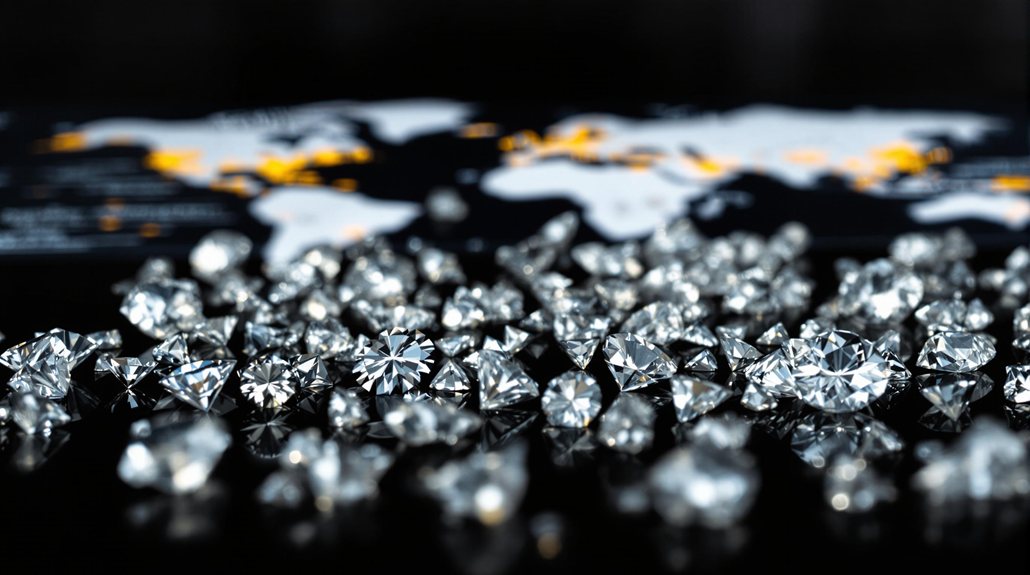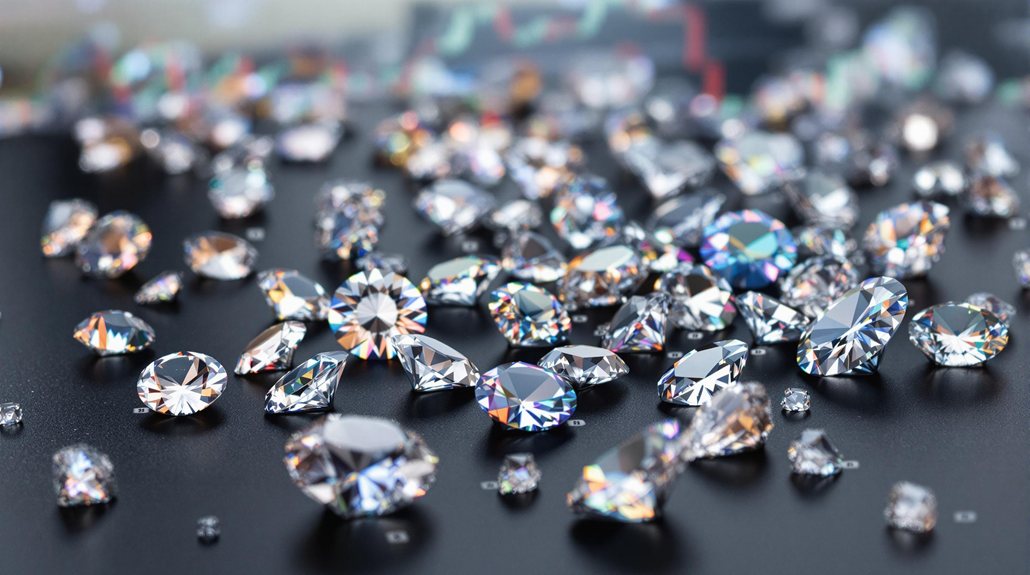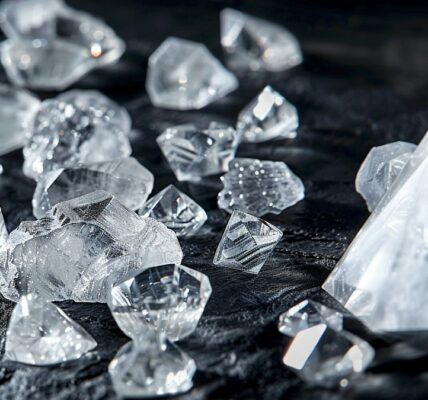Global diamond prices have hit a 14-year low, but the decline has started to decelerate. The Zimnisky index noted a 6% decline just in 2024. While smaller diamonds see reduced demand, larger stones over 3.00 carats retain their value, albeit with slower gains. Economic uncertainty, high inflation, and geopolitical tensions are key factors affecting these prices by disrupting supply chains and curbing luxury spending. However, experts foresee market recovery prospects by 2025, driven by technological innovations like lab-grown diamonds and potential stabilisation in the economic climate. To uncover more about these fascinating developments, the market’s future shines brightly.
Article Contents
Main Highlights
- Global diamond prices have decreased by 6% in 2024, continuing the downward trend from previous years.
- Diamond prices have reached a 14-year low, reflecting a 16% drop over the past 52 weeks.
- Economic uncertainties and geopolitical tensions are contributing to the ongoing decline in diamond market prices.
- The demand for smaller diamonds has weakened, whilst larger diamonds maintain stability with slower gains.
- Synthetic diamonds are gaining market share, impacting natural diamond prices and demand.
Current Price Trends
How have global diamond prices reached such lows? Recent trends indicate a significant downturn, with Zimnisky’s global rough diamond index revealing a 6% decline in 2024 alone. Current pricing shows diamonds at a 14-year low as of December 2023, though there has been slight recovery since. Over the last 52 weeks, prices have fallen by 16%, and a ten-year perspective reveals a 16.5% drop. This continuous decline highlights substantial market fluctuations affecting the industry’s stability.
An intriguing aspect of these fluctuations is the size-specific price trends. Smaller diamonds, particularly those in the 0. 50 to 1. 00 carat range, have experienced weakened demand and reduced pricing. Conversely, larger diamonds, especially those over 3. 00 carats, have maintained prices above the previous year’s levels, albeit with less significant gains. The overall market is being influenced by a shift in consumer preferences towards lab-grown diamonds, impacting the demand for natural diamonds. The increased interest in lab-grown diamonds is driven by ethical concerns and the emphasis on sustainable practices, which is reshaping consumer behaviour in the diamond industry. The labgrown diamond market slowdown has also had an impact on the overall diamond market, as it has led to increased competition and pricing pressure on natural diamonds. As a result, industry players are shifting their focus towards promoting the unique characteristics and value of natural diamonds to differentiate them from lab-grown alternatives. The continued evolution of consumer preferences and the ongoing influence of ethical and sustainable considerations are likely to shape the future trajectory of the diamond market.
It’s notable that the 4.00 carat polished diamonds saw a slower rise in September, with a year-over-year increase of less than 16%, down from nearly 20% in August. Meanwhile, the 2.00 to 3.00 carat segment witnessed declining demand and prices. These variations underline the complexity of the diamond market, where different segments can experience divergent trends simultaneously.
Contributing Factors
The global diamond market is currently facing significant challenges, driven by a mix of economic and geopolitical factors alongside the emergence of synthetic diamonds. Economic uncertainty in major markets and geopolitical conflicts, such as those involving Russia, have disrupted supply chains and weakened consumer demand for luxury items. Diamond prices declined by 18% from peak in February 2022, with a year-to-date price drop of 6.5% noted in the Global Rough Diamond Price Index. Furthermore, the growing popularity of synthetic diamonds, particularly among environmentally-conscious consumers, is reshaping market dynamics and contributing to the decline in natural diamond prices. Additionally, there is a notable shift towards ethically sourced diamonds, with rising demand for lab-grown options that are perceived as more sustainable and conflict-free.
Economic and Geopolitical Challenges
Global diamond prices are currently under considerable pressure due to a combination of economic and geopolitical challenges. Consumers are rethinking their spending habits, especially regarding luxury items like diamonds. The uncertainty in global economics, spurred by high inflation and recession fears, has greatly curtailed luxury spending in major markets, including the United States. Moreover, the post-pandemic recovery issues in China have further dampened consumer behaviour, as individuals prioritise experiences over material possessions. With the rise in popularity of synthetic diamonds, many consumers are opting for these alternatives due to their lower cost and ethical appeal, further affecting the demand for natural diamonds. The erosion of perceived value has led natural diamonds to lose appeal as a safe haven asset for investors, exacerbating the challenges in the market.
On the geopolitical front, conflicts such as the war in Ukraine have disrupted financial markets, creating a ripple effect on consumer confidence and spending. Supply chain disruptions, a direct consequence of these geopolitical tensions, have also impacted the availability of diamonds, leading to an unstable market environment. International sanctions, particularly those on Russia—a key player in diamond production—complicate market dynamics further, causing distrust in financial markets.
Such economic and geopolitical complexities underscore the pressures facing the diamond industry today. As consumers navigate these uncertain times, the shift in behaviour and spending patterns continues to influence the trajectory of global diamond prices, highlighting the intricate interplay between global events and market outcomes.
Rise of Synthetic Diamonds
Emerging as a formidable force in the diamond industry, synthetic diamonds are gaining traction due to several compelling factors. Remarkably, consumer preferences are shifting towards ethical sourcing and sustainability, making lab-grown diamonds an appealing choice. The electronics and semiconductor industries are also driving demand, leveraging technological advancements in production methods. High-temperature, high-pressure techniques and customisation for specialised uses further fuel this growth. In particular, the global synthetic diamonds market revenue is projected to rise significantly, highlighting the increasing importance of these factors. The Asia-Pacific region holds the largest market share as of 2023, underscoring its pivotal role in the market’s expansion.
| Contributing Factors | Details |
|---|---|
| Consumer Preferences | Increasing desire for ethical, conflict-free gems |
| Ethical Sourcing | Strong appeal due to minimal environmental impact |
| Electronics Industry | Major driver of market demand |
| Advanced Manufacturing | CVD and HPHT methods improve market growth |
| Global Market Trends | Expected growth to $21.4 billion by 2030 |
The synthetic diamond market is expected to grow substantially, with projections indicating a global market size of $21.4 billion by 2030. This growth is attributed to a compound annual growth rate (CAGR) of 4.9%. The U.S. market alone is valued at $4.1 billion in 2023, while China’s market is anticipated to expand at a CAGR of 8.5%. As synthetic diamonds capture a larger market share, their impact on natural diamond prices continues to be considerable, offering a sustainable and accessible alternative.
Market Forecasts
As we look towards the future of the diamond market, several key trends and influences come into play.
The growing popularity of synthetic diamonds, due to their ethical appeal, may markedly alter market dynamics and consumer preferences. The anticipated CAGR of 6.2% from 2024 to 2028 demonstrates the potential for growth in the industry. Furthermore, economic factors such as global volatility and shifting consumer spending habits will likely continue to shape the landscape, requiring stakeholders to adapt strategies for sustained success. With lab-grown diamonds posing a significant challenge to traditional players, the industry is witnessing a diversification in its supply chain that has become crucial for its adaptation.
Future Market Trends
Amidst the complex landscape of the global diamond market, future trends suggest a cautious yet optimistic outlook. As we look ahead, the market is anticipated to expand from an estimated $41.49 billion in 2024 to $50.23 billion by 2030, reflecting a compound annual growth rate (CAGR) of 3.3%. This growth is driven by strong demand from millennials in regions like Asia Pacific, which is poised to be a significant contributor alongside North America and Europe.
Key to this growth is the increasing emphasis on sustainable practices and evolving consumer preferences, particularly among younger generations who value ethical sourcing. The market’s expansion is also fuelled by the rise in disposable income in rapidly developing countries such as China, where it reached 47,412 CNY in 2021. The jewellery & ornaments segment dominated with a 98.0% revenue share in 2022, further underscoring the sector’s importance in driving growth. Economic factors, however, cast a shadow of uncertainty.
Global economic instability, from inflationary pressures to geopolitical conflicts, continues to influence consumer spending patterns, particularly in luxury markets. Yet, the demand for jewellery remains robust in emerging economies such as China and India, while the industrial sector’s reliance on diamonds further supports market stability. Despite short-term challenges, experts predict a potential market recovery by 2025, contingent on economic stabilisation. Long-term, the market’s growth prospects remain promising, with untapped potential in Central and South America, offering a guiding light of hope amid current uncertainties.
Synthetic Diamonds Impact
The impact of synthetic diamonds on the global diamond market is becoming increasingly significant, reshaping industry dynamics and consumer behaviour. As synthetic diamonds capture up to 20% of the diamond jewellery market, they present a compelling alternative to natural diamonds, particularly for those concerned with sustainability. The synthetic diamond market, with major production in China and India, is projected to grow steadily, reaching a value of USD 41.6 billion by 2032.
This growth is driven by consumer education on the ethical and environmental benefits of lab-grown diamonds, offering a more sustainable option without compromising on quality. The Asia Pacific region, driven by rapid industrialisation, generated USD 8.3 billion in 2023 and is expected to reach USD 14.3 billion by 2032, highlighting the significant geographic demand for synthetic diamonds. In 2022, China produced 20 million carats of synthetic diamonds, representing a substantial portion of global production and underscoring the scale of growth in this segment.
Wholesale prices of synthetic diamonds have decreased dramatically, making them more accessible and appealing to a wider audience. Affordability, combined with ethical sourcing, aligns with consumer preferences that increasingly prioritise sustainability concerns. This shift has influenced natural diamond sales, especially in lower price ranges, highlighting the growing acceptance of synthetic alternatives. The divergence in pricing and perception between synthetic and natural diamonds suggests a future where both coexist, catering to different segments of the market. As synthetic diamonds continue to evolve and gain consumer trust, they are likely to remain a significant force in the diamond industry.
Economic Influences Overview
Economic influences play a pivotal role in shaping the diamond market‘s trajectory, with global uncertainties casting a shadow on demand. High inflation and recession fears in major economies, particularly the United States, lead to demand fluctuations for diamonds. Consumer priorities shift during economic instability, with reduced spending on luxury items like diamonds. This shift is further exacerbated by geopolitical conflicts, such as the war in Ukraine, which disrupt supply chains and contribute to market volatility.
In addition to these challenges, the weakening diamond prices have been observed for twelve consecutive months, indicating ongoing market pressures. As the market navigates these challenges, experts predict a potential recovery by 2025, contingent on global economic stabilisation and a resurgence in consumer confidence. Despite current setbacks, the diamond market is projected to grow from $2.59 billion in 2024 to $3.29 billion by 2028, driven by demand in regions like Asia Pacific and Europe. Younger consumers, especially millennials in Asia, are vital to this growth, although their preference for experiences over material goods affects traditional diamond demand.
Moreover, geopolitical tensions and trade policies continue to impact the market. Sanctions on diamond-producing countries and political instability create supply chain constraints, influencing diamond pricing and availability. Monitoring trade agreements among diamond-producing and consuming nations is essential to understanding market dynamics. In this climate, understanding consumer priorities and market trends becomes fundamental for stakeholders.
Industry Innovations
Industry innovations are transforming the diamond sector, with lab-grown diamonds leading the charge towards sustainability and quality improvement. These synthetic gems boast improved quality with fewer imperfections and vibrant colours, making them nearly indistinguishable from their natural counterparts. As production capacity expands through technological advancements, the diamond industry is increasingly embracing cutting technologies like advanced laser cutting and AI-powered grading.
These innovations guarantee precise cuts, optimise yield, and maintain high quality while minimising waste. Furthermore, the integration of AI and automation enhances operational efficiencies, allowing the industry to produce diamonds more consistently and at a lower cost. Blockchain transparency plays a pivotal role in providing ethical sourcing and building trust among consumers.
By tracing the origin and attributes of lab-grown diamonds, blockchain technology assures authenticity and combats the problem of conflict diamonds. Sustainable practices are also gaining traction, with eco-friendly techniques reducing the environmental impact of diamond production. Advances in production techniques have enabled the creation of larger diamonds without compromising quality, meeting the growing consumer demand for substantial gemstones.
Nanotechnology advancements open new avenues, allowing the creation of diamonds with superior hardness and thermal properties. Augmented reality improves customer experience, offering virtual try-ons and immersive training for diamond professionals. Together, these innovations not only increase the appeal and accessibility of diamonds but also align with the values of a freedom-seeking audience, enthusiastic for sustainable and ethically sourced luxury.
Regional Price Variations

Amid the shifting dynamics of the global diamond market, regional price variations emerge as a crucial factor influencing consumer purchasing decisions. The allure of competitive pricing strategies forms the crux of market competition, making certain regions more attractive to diamond buyers. In India, the extensive diamond cutting and polishing industry enables competitive pricing due to lower labour costs, enhancing its appeal.
Meanwhile, Belgium, particularly Antwerp, utilises its proximity to diamond trading hubs and high trade volume to offer favourable prices with retail markups ranging from 10% to 20%. Dubai’s tax-free shopping environment provides another compelling option for consumers seeking advantageous pricing strategies.
This aspect distinctly positions Dubai in the diamond market, attracting buyers who are keen on maximising their purchasing power. Thailand’s vibrant market, with its abundance of choices, likewise benefits from relatively low prices compared to Western countries. However, the United States and China experience a downturn in demand due to economic uncertainties, impacting global supply and subsequently pricing. Moreover, the rise of synthetic diamonds introduces more affordable alternatives, further influencing regional price variations.
South Africa’s direct-from-mine sales also offer special opportunities for acquiring diamonds at competitive prices. Additionally, lab-grown diamonds are typically more affordable than natural diamonds, presenting consumers with cost-effective alternatives and contributing to regional price differences. Diamonds are priced based on market comparisons of similar characteristics, which significantly influence regional pricing strategies.
Expert Perspectives
The diamond market is experiencing a multifaceted downturn, with experts attributing the decline in prices to a confluence of economic uncertainties, geopolitical tensions, and evolving consumer preferences. The global diamond market is projected to grow by USD 42.72 billion from 2024 to 2028, underscoring the potential for market recovery despite current challenges. Market segmentation reveals that synthetic diamonds are gaining traction, particularly among younger, environmentally-conscious consumers. This shift in consumer behaviour poses a significant challenge to traditional diamond markets, which are already grappling with reduced demand due to economic instability and geopolitical disturbances, such as the ongoing conflict in Ukraine.
Experts highlight several key factors influencing the current market dynamics:
- Economic uncertainties leading to decreased demand for luxury goods, including diamonds.
- Geopolitical tensions and international sanctions affecting major diamond producers.
- Changes in consumer behaviour, with a notable preference for synthetic over natural diamonds.
- Emerging trends towards customisation and personalisation in diamond jewellery.
Despite these challenges, some analysts forecast a potential market recovery by 2025, contingent upon the stabilisation of global economies. The market is expected to reach $3.29 billion by 2028, driven by demand for luxury goods and industrial applications. The anticipated growth, however, is expected to be driven primarily by synthetic diamonds and wedding jewellery.
The diamond market’s future remains uncertain, as it navigates the complex interplay of global economic conditions and shifting consumer preferences, demanding adaptability and innovation from industry stakeholders.
Frequently Asked Questions
How Do Diamond Prices Compare to Gold Prices?
Diamond market trends reveal distinct dynamics compared to gold investment comparison. While diamond prices depend on the 4Cs and market demand, gold prices are influenced by economic conditions, interest rates, and currency values, affecting investment appeal.
Are There Ethical Concerns With Lab-Grown Diamonds?
Amidst the shimmering allure of lab-grown diamonds lies a shadow of ethical sourcing dilemmas. Consumer awareness is paramount, as coal-dependent production and misleading eco-friendly claims challenge the perceived sustainability of these sparkling alternatives to mined gems.
What Is the Environmental Impact of Diamond Mining?
Diamond mining results in significant environmental degradation, causing ecosystem disruption, water pollution, and habitat loss. Furthermore, its substantial carbon footprint contributes to climate change, demanding urgent sustainable practices to protect natural habitats and guarantee a balanced ecological future.
How Do Diamond Prices Affect Jewellery Resale Value?
Diamond prices greatly influence jewellery resale value, with market trends dictating demand fluctuations. Resale value factors include diamond size, shape, quality, and certifications, compounded by economic conditions and industry mark-ups, impacting potential returns for sellers seeking freedom in financial decisions.
What Are the Tax Implications of Buying Diamonds?
Understanding the tax implications of purchasing diamonds involves diamond valuation methods and luxury tax considerations. Buyers should take into account location-based taxation, potential customs duties, and insurance costs. Proper valuation ensures compliance, maximises tax benefits, and safeguards financial freedom.
Our Final Thoughts
The diamond market, like a vast ocean, is experiencing waves of change, with prices dipping but the descent slowing. Influenced by a myriad of factors, from technological innovations to regional variations, the market’s future remains a tapestry woven with uncertainty and opportunity. Experts predict a cautious optimism, suggesting that whilst challenges persist, innovation and adaptation may steer the ship towards calmer waters. Consequently, the diamond industry’s evolution is a reflection of resilience amid shifting tides.




